Last week I wrote an entire grant for one of my Grant Writing Made Easy students in just one hour. All I had to build this grant upon was one sentence from the student on what the nonprofit is called, where it’s located, and what its mission is. I used ChatGPT, providing it with multiple prompts to get more detail until we had 13 single-spaced pages of a quality grant proposal that I would feel confident in submitting to any foundation after the addition of some research and small revisions. (Don’t worry, I’m building an entire training on how you can do this, too.)
In this post, I’ll share some of my strategies for using ChatGPT to generate content for your grant proposal and then refining that content to create a compelling case for funding.
Use ChatGPT to Generate Content for your Grant Proposal
ChatGPT is an AI language model that generates text based on the input you provide. It can be used to generate text for different sections of the grant proposal, such as the introduction, problem statement, proposed solution, and budget.
To use ChatGPT effectively, it’s important to provide clear and specific prompts. For example, if you want ChatGPT to generate text for the problem statement section of the grant proposal, you could provide a prompt like “Describe the problem that this grant proposal seeks to address.” You can then use the output generated by ChatGPT as a starting point for your own writing, editing and refining the text as needed to ensure that it is accurate, concise, and persuasive.
Tips for engineering prompts to get ChatGPT to generate content for your grant proposal. Prompt engineering is the process of designing clear and effective prompts that guide ChatGPT to generate the desired output. To use ChatGPT effectively, it’s essential to understand best practices for prompt engineering. In this blog post, we will discuss some of the key best practices for prompt engineering that you can use to generate high-quality content from ChatGPT.
Be clear and specific
Clear and specific prompts are essential for getting the best results from ChatGPT. Ambiguous or vague prompts can lead to irrelevant or unhelpful output. To create effective prompts, think carefully about what you want ChatGPT to generate and phrase your prompts in clear and specific language.
For example, instead of using a prompt like “Write a paragraph about our nonprofit,” you might use a prompt like “Describe our nonprofit’s mission and the key programs we offer.” This specific prompt will help ChatGPT generate more relevant and useful content.
Use examples
Providing examples can help to clarify what you’re looking for and provide ChatGPT with context. For example, if you want ChatGPT to generate a description of your nonprofit’s impact, you should provide a few examples of the types of impact your organization has had in the past. This will help ChatGPT generate more accurate and relevant content that reflects the specific impact your organization has had.
Use multiple prompts
Using multiple prompts can help to generate more comprehensive and well-rounded content from ChatGPT. By providing a range of prompts that focus on different aspects of your organization or project, you can generate a variety of ideas and approaches that you can then refine and combine to create a strong and effective output.
For example, I started working on a grant for new nonprofit by prompting GPT with the following: “Can you write a grant for a nonprofit called Averitte House founded in 2022 to provide food and clothing for veterans and women with children experiencing homelessness in San Diego, California.
With that information and request, it may come up with a very general text that briefly outlines these six sections of a grant proposal: Introduction, Purpose, Project Goals, Budget, Timeline, and Conclusion with one minimal paragraph for each section.
To get a more detailed proposal you can prompt ChatGPT to expand on each section. For example, in the same chat, I asked it: “Can you give a more complete timeline breakdown for the project you just wrote about?” Rather than one short paragraph outlining what will be accomplished in one year, it created 3-4 bullet points for each one to two months. And those bullet points were legitimate activities that would contribute to the program it described. Then you can do that for each section or even ask it to add sections, as I did for the statement of need, until you have a complete draft to work from.
Be mindful of bias in ChatGPT
ChatGPT is trained on large datasets of text, which can include biases and stereotypes. To avoid perpetuating bias in your generated content, it’s essential to be mindful of the prompts you use and the output generated by ChatGPT. Review the output carefully to ensure that it does not contain any biased or offensive language, and adjust your prompts as needed to avoid bias.
Use formatting and punctuation in your prompts
Formatting and punctuation can help to guide ChatGPT and generate more accurate and helpful output. For example, using bullet points or numbered lists can help to structure your prompts and generate more structured output. Using appropriate punctuation, such as question marks or colons, can also help to guide ChatGPT and generate more relevant output.
Prompt engineering is a critical component of using ChatGPT effectively. By using clear and specific prompts, providing examples, using multiple prompts, being mindful of bias, and using formatting and punctuation, you can generate high-quality content from ChatGPT that reflects the specific needs and goals of your organization or project. With these best practices in mind, you can use ChatGPT to streamline your writing process and create compelling content that supports your mission and goals.
Once you have generated content for your grant proposal using ChatGPT, the next step is to review and revise the proposal to ensure that it meets all of the requirements of the grant opportunity and effectively communicates your nonprofit’s mission, goals, and proposed project.

4 Tips for Reviewing and Revising your Grant Proposal
- Focus on clarity and conciseness: Grant proposals should be clear, concise, and easy to understand. Take the time to review each section of the proposal and ensure that the language is straightforward and free of jargon or technical terms that may be unfamiliar to the grant-making organization.
- Use active voice: Using active voice can help to make your grant proposal more engaging and compelling. Instead of writing “The problem will be addressed,” write “We will address the problem.”
- Add specific examples: Do your research and provide specific examples and evidence can help to make your grant proposal more persuasive. Use data, case studies, and testimonials to demonstrate the impact of your nonprofit’s work and the need for the proposed project.
- Ensure consistency and accuracy: Double-check all information in the grant proposal to ensure that it is accurate and consistent. This includes budget figures, organizational information, and any supporting documentation that may be required.
- Revise for word or character-count requirements. ChatGPT doesn’t have a built-in function to shorten text to a specific word or character count. However, there are some techniques you can use to shorten text with the help of ChatGPT. One approach is to use ChatGPT to generate summaries or paraphrases of the original text that are shorter in length. Here are the steps you can take:
- Input the original text into ChatGPT.
- Ask ChatGPT to generate a summary of the text, specifying the desired length of the summary in terms of the number of words or characters.
- Review the summary and revise it as needed to ensure that it captures the main ideas and key points of the original text.
- Repeat the process if necessary to further shorten the text.
It’s important to review the resulting text carefully to ensure that it still conveys the intended meaning and is grammatically correct. It’s also important to be mindful of any potential loss of nuance or detail that may occur when text is shortened.
ChatGPT is a Tool for Grant Writing. It’s Not a Grant Writer.
In conclusion, using ChatGPT can be a powerful tool for streamlining the grant writing process and increasing your chances of success. By using clear and specific prompts to generate content and taking the time to review and revise the proposal, you can create a compelling case for funding that effectively communicates your nonprofit’s mission, goals, and proposed project.
However, it’s important to remember that ChatGPT is not a replacement for human writing and editing. It is a tool that can help to generate ideas and streamline the writing process, but it’s up to you to review, refine, and revise the content generated by ChatGPT to ensure that it meets the specific requirements of the grant opportunity and effectively communicates your nonprofit’s mission and goals.
By following these tips and strategies for using ChatGPT to generate content and refine your grant proposal, you can create a strong and compelling case for funding that increases your chances of success. With persistence and dedication, you can secure the funding your nonprofit needs to continue its important work and make a positive impact in your community and beyond.
If you want to be the first to know when registration opens for my brand-new training on how to write a full grant in one hour using AI, sign up for the waitlist.







Kim
February 27, 2023 9:13 pmGame changer. Volunteer on a small board for a small nonprofit, that’s doing big things in our community. Have done a lot of technical writing, so have been deemed “it” for grants. Was really struggling with wording, and with understanding form fields that appeared to be asking the same question. Using the AI not only taught me difference in the questions, it also taught me wording that didn’t sound like a tech manual. Sincere thanks.